Flow is a concept commonly associated with yoga, but have you ever
tried sequencing non-yoga-based strength, balance and flexibility moves
all together, without any breaks or pauses? The following flow routine
featuring the TRX Suspension Trainer
is a great way to harness the benefits of flow, with its balance
challenges and constant movement, while also targeting flexibility,
strength and mobility. Each of these movements is relatively simple, but
when performed slowly and with control, they combine to create a unique
and challenging workout that your clients and class participants are
sure to love.
Note: Each of these sequences requires thoughtful movement and great body awareness. Help your participants focus on what is happening to their bodies as they work through the flow. Does their core want to disengage because the strength of a single leg movement is too tough? Are they compensating a lift of the leg because of mobility and flexibility challenges? These types of questions will help your clients begin to notice how their bodies cheat movement. Until they feel it, they can’t make the appropriate adjustments. These flows can assist in exposing the areas where the body compensates for imbalances or weaknesses.
1. Core Flow
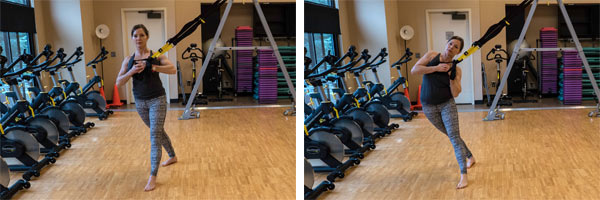
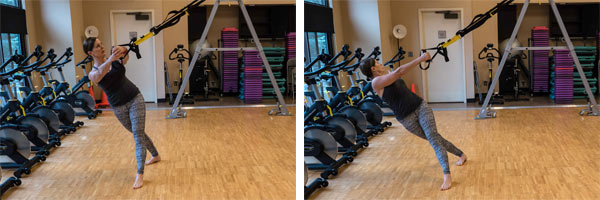
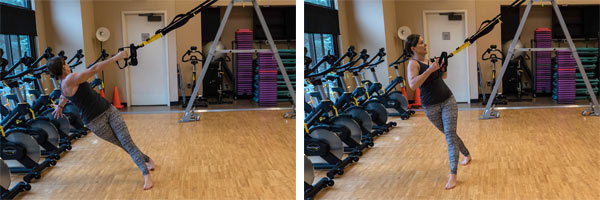
This sequence uses eccentric loading of the side body, core stabilization, rotation, thoracic opening, single-leg balance and strength.
Adjust the TRX Suspension Trainer to mid-length; stand sideways on the left side of the anchor. Stand in an off-set position, hip in line to anchor. Put the handles in single-handle mode and hold in front of the sternum. Maintain good posture, with shoulders down, ribs in, body in a straight line and eyes at the horizon. Lower to your edge and raise back up. Press the handle straight out from the sternum, maintaining tension on the straps and keeping the arms straight. Bring the arms toward the anchor, being sure to keep the body in plank position without any sagging. As you reach the center, release the right arm and reach toward the floor, opening the chest and maintaining strong hips and legs. Raise back up, grab the handle and pull the body into a row position, bringing the handles back to the sternum. Rotate back to sideways, extend the right leg in front and lower to a squat. Raise back up, holding on one leg with the right leg extended and straight, before lowering the leg back to the starting position. Repeat the entire sequence on the other side.
2. Crossing Lunge Flow
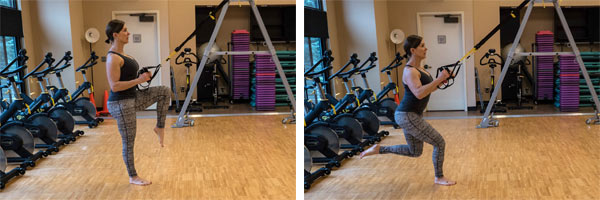
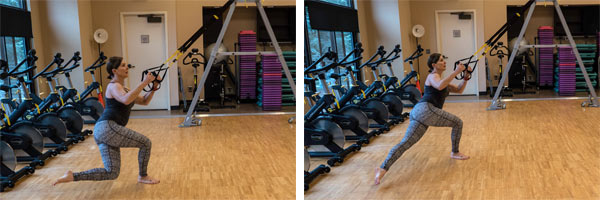
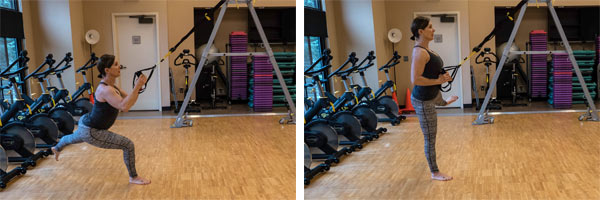
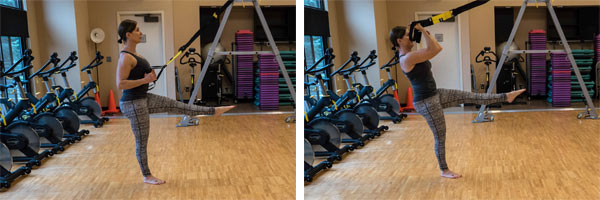
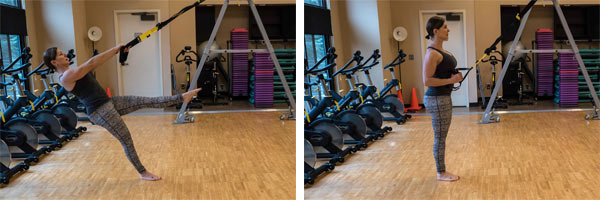
This flow challenges upper- and lower-body strength and mobility.
Adjust the TRX Suspension Trainer to mid-length. Stand facing the anchor point, holding the handles with palms facing each other and the elbows under the shoulders. Center the right leg to the anchor point and lift the left leg with the knee bent. Lower the tailbone toward the floor into a single-leg lunge position. Drive the knee behind the right leg, keeping a 90-degree bend in the knee. Extend the leg from this position and circle it behind the body and toward the left side of the body. Keep the leg straight and abducted, with the foot flexed and the toes and knee facing strength ahead. Extend the right leg to stand as you bring the left leg to the front. Be sure to keep the torso lifted and the core strong, being careful not to lean to the side or the back. Bring the arms up, elbows in line with the shoulders, and the palms facing away from your face. Extend the arms and curl back to the starting position.
3. Lunge to Stand Flow
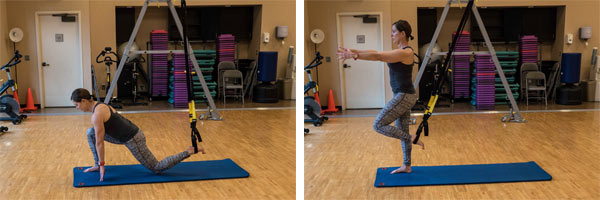
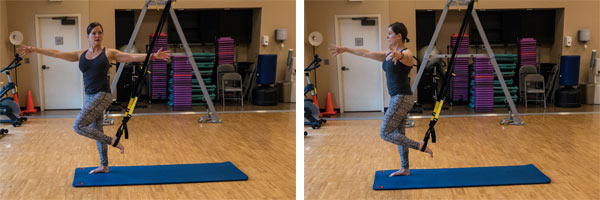
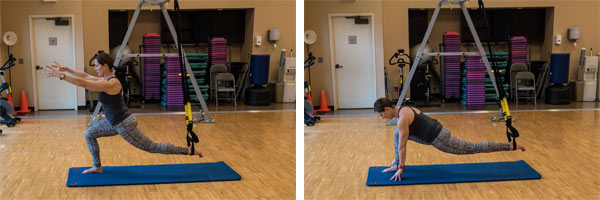
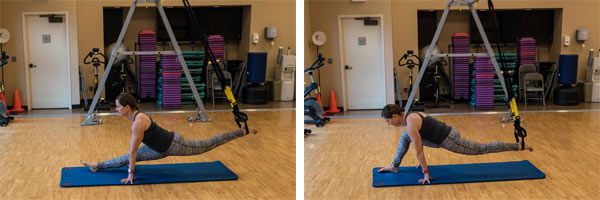
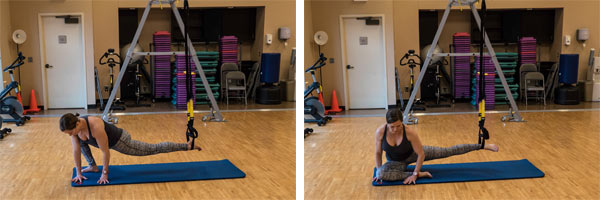
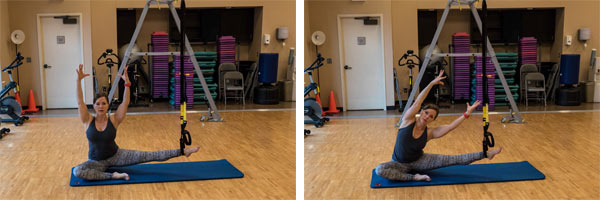
This sequence challenges flexibility, mobility and strength through hips, legs, ankles and thoracic spine.
Adjust the TRX Suspension Trainer to mid-calf. Face away from the anchor and place the left foot in the foot cradle and assume a runner’s lunge position. Keep the chest lifted, spine tall and the left glute engaged. Hinge the hips back, keeping the right leg straight and the spine long. Using your right leg, pull forward and then press up to stand. Maintain tension on the straps by keeping the left leg weighted in the straps. As you come to stand, extend the arms out from the chest to about shoulder-width apart. Keep the shoulders down and the ribs in while maintaining strong arms and core. Keep the right arm straight as you begin to move the left arm toward the back wall, rotating toward the left and following your arm with your eyes. Your arms should be in a T formation. Bring the left arm back to the front and extend the left leg behind you. With the spine tall, lower the knee toward the floor. Once you reach 90 degrees, reach the arms toward the floor to extend the back. Keep the right heel in place as you continue pressing the body back until both legs are straight in a split. Pull the body forward, using fingertips, if needed. Lift the right foot and pivot the body, while bending the knee to face the left side of the anchor. Extend arms overhead and reach toward the anchor and bring the torso back to an upright position. Repeat on the other side.
Note: Each of these sequences requires thoughtful movement and great body awareness. Help your participants focus on what is happening to their bodies as they work through the flow. Does their core want to disengage because the strength of a single leg movement is too tough? Are they compensating a lift of the leg because of mobility and flexibility challenges? These types of questions will help your clients begin to notice how their bodies cheat movement. Until they feel it, they can’t make the appropriate adjustments. These flows can assist in exposing the areas where the body compensates for imbalances or weaknesses.
1. Core Flow



This sequence uses eccentric loading of the side body, core stabilization, rotation, thoracic opening, single-leg balance and strength.
Adjust the TRX Suspension Trainer to mid-length; stand sideways on the left side of the anchor. Stand in an off-set position, hip in line to anchor. Put the handles in single-handle mode and hold in front of the sternum. Maintain good posture, with shoulders down, ribs in, body in a straight line and eyes at the horizon. Lower to your edge and raise back up. Press the handle straight out from the sternum, maintaining tension on the straps and keeping the arms straight. Bring the arms toward the anchor, being sure to keep the body in plank position without any sagging. As you reach the center, release the right arm and reach toward the floor, opening the chest and maintaining strong hips and legs. Raise back up, grab the handle and pull the body into a row position, bringing the handles back to the sternum. Rotate back to sideways, extend the right leg in front and lower to a squat. Raise back up, holding on one leg with the right leg extended and straight, before lowering the leg back to the starting position. Repeat the entire sequence on the other side.
2. Crossing Lunge Flow





This flow challenges upper- and lower-body strength and mobility.
Adjust the TRX Suspension Trainer to mid-length. Stand facing the anchor point, holding the handles with palms facing each other and the elbows under the shoulders. Center the right leg to the anchor point and lift the left leg with the knee bent. Lower the tailbone toward the floor into a single-leg lunge position. Drive the knee behind the right leg, keeping a 90-degree bend in the knee. Extend the leg from this position and circle it behind the body and toward the left side of the body. Keep the leg straight and abducted, with the foot flexed and the toes and knee facing strength ahead. Extend the right leg to stand as you bring the left leg to the front. Be sure to keep the torso lifted and the core strong, being careful not to lean to the side or the back. Bring the arms up, elbows in line with the shoulders, and the palms facing away from your face. Extend the arms and curl back to the starting position.
3. Lunge to Stand Flow






This sequence challenges flexibility, mobility and strength through hips, legs, ankles and thoracic spine.
Adjust the TRX Suspension Trainer to mid-calf. Face away from the anchor and place the left foot in the foot cradle and assume a runner’s lunge position. Keep the chest lifted, spine tall and the left glute engaged. Hinge the hips back, keeping the right leg straight and the spine long. Using your right leg, pull forward and then press up to stand. Maintain tension on the straps by keeping the left leg weighted in the straps. As you come to stand, extend the arms out from the chest to about shoulder-width apart. Keep the shoulders down and the ribs in while maintaining strong arms and core. Keep the right arm straight as you begin to move the left arm toward the back wall, rotating toward the left and following your arm with your eyes. Your arms should be in a T formation. Bring the left arm back to the front and extend the left leg behind you. With the spine tall, lower the knee toward the floor. Once you reach 90 degrees, reach the arms toward the floor to extend the back. Keep the right heel in place as you continue pressing the body back until both legs are straight in a split. Pull the body forward, using fingertips, if needed. Lift the right foot and pivot the body, while bending the knee to face the left side of the anchor. Extend arms overhead and reach toward the anchor and bring the torso back to an upright position. Repeat on the other side.

No comments:
Post a Comment